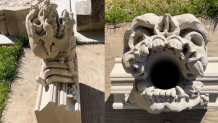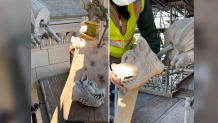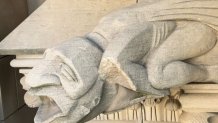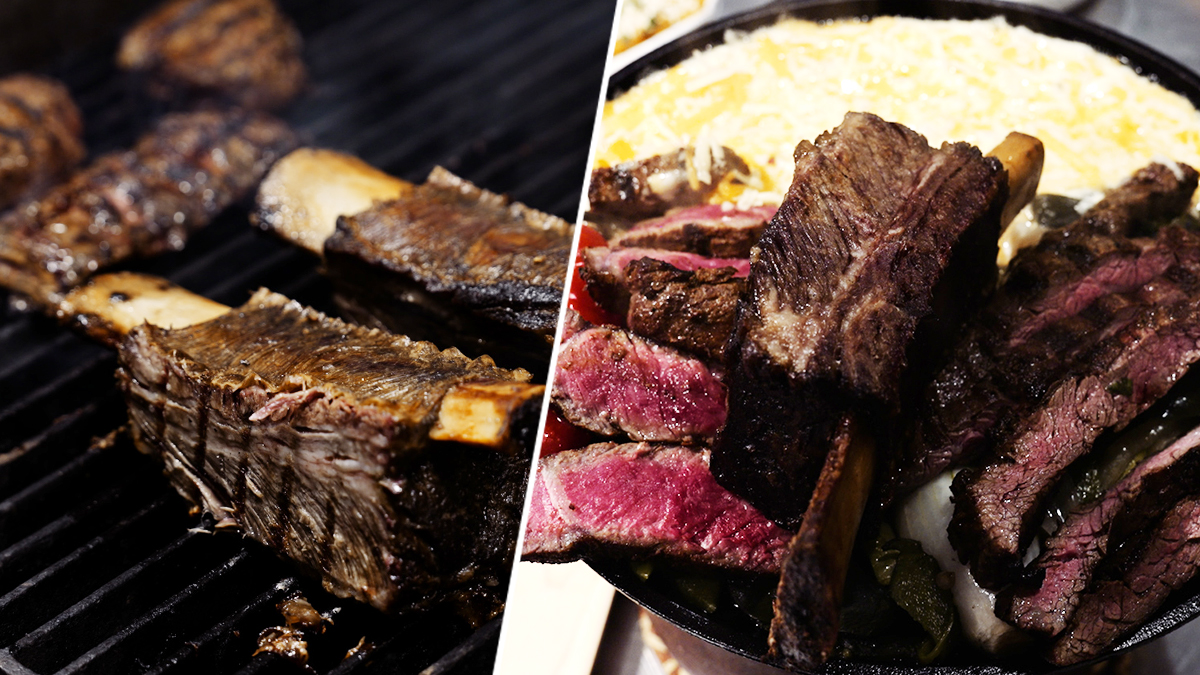The Washington National Cathedral calls itself "a house of prayer for all people, conceived to serve as a great church for national purposes." In other words, the cathedral is designed to capture and reflect the essence of America and its culture.
So what better icon to carve onto the building than Darth Vader, the infamous villain from "Star Wars?"
According to National Cathedral chief of communications Kevin Eckstrom, the Sith lord looms over the north side of the Cathedral because of a 1985 contest sponsored by children's magazine National Geographic World.
The magazine took submissions from readers, and then counted votes for the different options to decide what stonemasons would actually carve. Darth Vader came in fourth, "but don't tell him that," Eckstrom said. Vader is already on the dark side -- literally, keeping watch on the north side of the Cathedral, which gets less light.
We're making it easier for you to find stories that matter with our new newsletter — The 4Front. Sign up here and get news that is important for you to your inbox.
Other winners of the contest, affixed since 1986 to nearby gablets on the building, include a toothy man holding an umbrella, a girl with big teeth and braces, and a raccoon. Despite Vader being the only pop-culture figure decorating the building, Eckstrom says the Cathedral has never heard from Disney or George Lucas about any copyright concerns.
"We're assuming 30 years in, that they're all right with that," he said.
The "Star Wars" villain is just one of the many intriguing carvings that decorate the building.
Local
Washington, D.C., Maryland and Virginia local news, events and information
What Counts as a Gargoyle?
"All gargoyles are grotesques, but not all grotesques are gargoyles," Eckstrom explained.
Around 1,130 of the carvings on the building are grotesques, which, according to Eckstrom, mainly serve as decoration. They can look like animals, humans, humanoids, or "crazy devilish looking things."
Gargoyles are a subgenre of grotesque that serve a functional purpose, and there are about 112 of them on the National Cathedral. They're used as part of the rain gutter system.
Gargoyles are grotesques that have pipes in their mouths, and they carry water away from the building. The gargoyles on the highest level funnel the water to the next layer of gutters and gargoyles further down, creating "a cascading system of gargoyles that ultimately push the water down to the ground level," Eckstrom said.
That's a very important function to avoid damage on a building made of carved stone.
"One of the worst things you can have in a stone building is water," Eckstrom said.
The gargoyles tend to be larger than the grotesques, generally between two and three feet in size. But beyond that requirement, "there was no rulebook" for the stonemasons carving the creatures.
"Sometimes, you know, they would get instructions like, 'oh, make it look like this person,' or, 'we want to represent'" a particular idea or concept, Eckstrom said.
Historically, during the medieval era, gargoyles were "a way that the church adopted popular culture," Eckstrom said.
"There was a belief in evil spirits, and so they put these gargoyles, these scary-looking creatures, on the building to repel the evil spirits," Eckstrom said. "That's originally why they were sort of spooky looking."
The National Cathedral's gargoyles, mostly carved in the 1960s, '70s and '80s, tend to be more whimsical than frightening, Eckstrom said. And for the most part, "the carvers were really allowed to let their imagination run wild."
The caveat was that the designs did have to be approved by the head stonemason at the time of construction — and there is at least one gargoyle that didn't make the cut, according to current Head Stonemason Joe Alonso.
Rejected Gargoyle

That gargoyle is a grimacing skeleton, with a bulbous head, hollow staring eyes, large molars and knobbly, visible ribs.
"This guy was supposed to actually go up on the west towers," Alonso said. But the gargoyle, as Alonso heard it, was rejected because of the way it was carved.
"Whenever you carve something on the outside of the building, it has to be carved in a way that the water will wash over it, flow over it," Alonso said.
Unfortunately, the nooks and crannies in the gargoyle's ribs and the flat surface of his head meant that "this could have potentially held water, and would not have shed the water properly," Alonso said. "So they rejected it."
The carver created another gargoyle that did go on the building, according to Alonso, but the first rejected creature has floated around the National Cathedral over the years. At one point, the gargoyle was sold to someone who rigged it up near their backyard swimming pool, Alonso said — but when the buyer moved, they donated it back to the Cathedral.
"The poor guy has had quite a journey all his life," Alonso said, patting the gargoyle's skeletal head.
Meet "Decap"
"Decap" is another gargoyle that has seen his fair share of trouble.
Originally known as "Bat-like," according to a gargoyle guidebook published by the Cathedral in 2003, Decap got his nickname because he was decapitated during the region's infamous 2011 earthquake.
That magnitude-5.8 quake, which lasted about 58 seconds, did significant damage to buildings around D.C. Taller structures took the biggest hits, as the energy from the earth searched for outlets and traveled up the highest buildings.
Decap's home on the west side of the south transept puts him right under on of the large pinnacles that came loose and twisted around in 2011.
"All that energy, it's like a giant hand took that big pinnacle and spun it counter clockwise," Alonso said.
The gargoyle's home was on a balcony about 20 feet below that twisted pinnacle.
The twisting meant "some big chunks of stone came off the columns... and probably a big sized chunk of stone, probably 30- [to] 40-pound hunk of stone, came down just right and struck him in the head and snapped it off very cleanly," Alonso said.

Miraculously, none of the falling stones hurt anyone in their journey down to earth, and Decap's head didn't even make it all the way to the ground.
"Luckily, the lead drain pipe that runs through the gargoyle's mouth held the head," Alonso said. "It was dangling off the pipe for two and a half months until we were able to get up there with a crane that October."
The painstaking repair work on the National Cathedral is still ongoing, twelve years after the earthquake. It's cost about $24 million so far, with about $14 million worth of repair work still to go, mostly in the central tower, Eckstrom said.
Some of that work includes internal reinforcements in the form of stainless steel rods, which will keep the stone pinnacles and spires secure should another earthquake strike the D.C. area, Eckstrom said.
Other repairs are more aesthetic. Alonso and his crew are fixing Decap this summer, as they perform other work on scaffolding high up on the south transept.
"We'll do a little re-capitation of the head," Alonso said. "We'll drill some stainless steel rods in there, and pins, and use a special epoxy that we use on stone, and we'll get him back good as new."
"Then his name will be changed to Recap," Alonso said.
Decap was one of only two gargoyles, out of the 112 on the building, that were damaged in the quake.
The other, known as "Flat-nosed Humanoid," is missing a chunk from its left arm — likely also due to a piece of stone falling from above, Alonso says. That gargoyle is still solidly attached to the building.
"One of our stone carvers, very talented guy, Andy, will be up there this summer carving a new arm form," Alonso said. "So what he'll do is cut out a pocket and graft a block of stone in the place where the arm was, and then he'll be able to re-carve the arm using, I guess his right arm, as an example."

Where Are the Gargoyles?
With a grand total of 1,242 gargoyles and grotesques on the National Cathedral, there's no shortage of carvings for visitors to seek out.
Other notable gargoyles and grotesques include:
- Medusa: This gargoyle is the personal favorite of Alonso, "if I had to choose one," he said. He helped install her on the southwest tower, and she was among the last gargoyles to be carved for the Cathedral back in the 1980s. "She is just magnificent. Snakes in the hair, the whole deal."
- Rattlesnake: If Eckstrom had to pick another favorite carving after Darth Vader, he said he'd go with the rattlesnake on the north nave. Rattlesnakes are indigenous to North America, Eckstrom explained, and the carvers wanted to add "a distinctly American animal on the Cathedral."
- Donkey and Elephant: It's D.C., so of course the Cathedral has a nod to American politics. On the south nave, a trumpeting elephant and a donkey with its ears thrown back are carved onto each corner of the gablet. They were added during the 1968 election.
Some of the gargoyles and grotesques can be spotted from the ground. The National Cathedral's website has an interactive map here, which you can use anytime during the dawn-to-dusk visiting hours of the Cathedral grounds.
If you want to get closer to the high-up carvings, like Darth Vader, however, the Cathedral offers a special "Angels and Monsters Tower Climb" a couple of times per month during the spring and summer. You can buy tickets for about $50 here, but be warned — tickets sell out fast, according to Eckstrom.
You won't be able to head up on the scaffolding, but to get to the high-up balconies, tour-takers need to climb steep steps and walk through narrow hallways and doors, so it's not ideal for anyone claustrophobic or afraid of heights.



